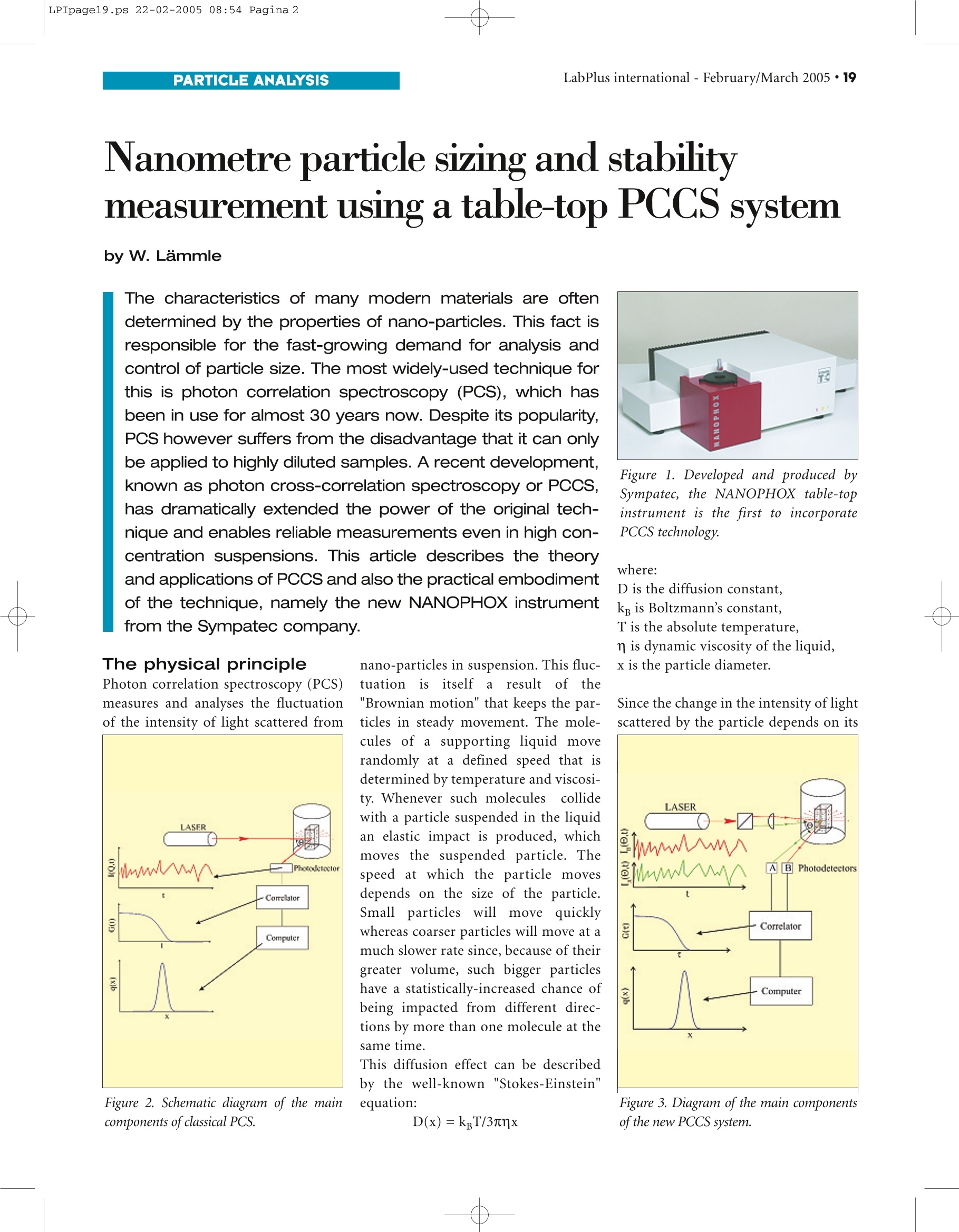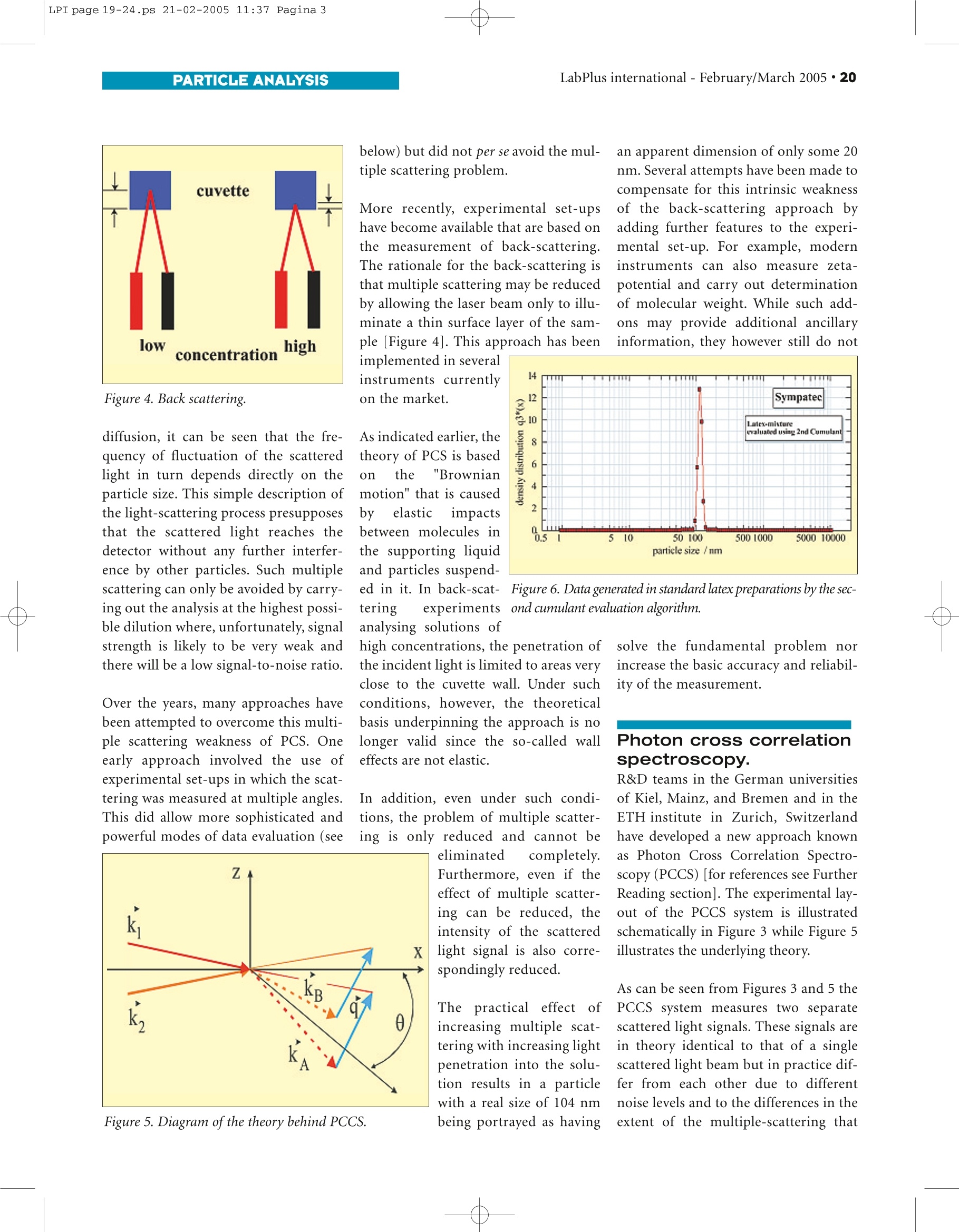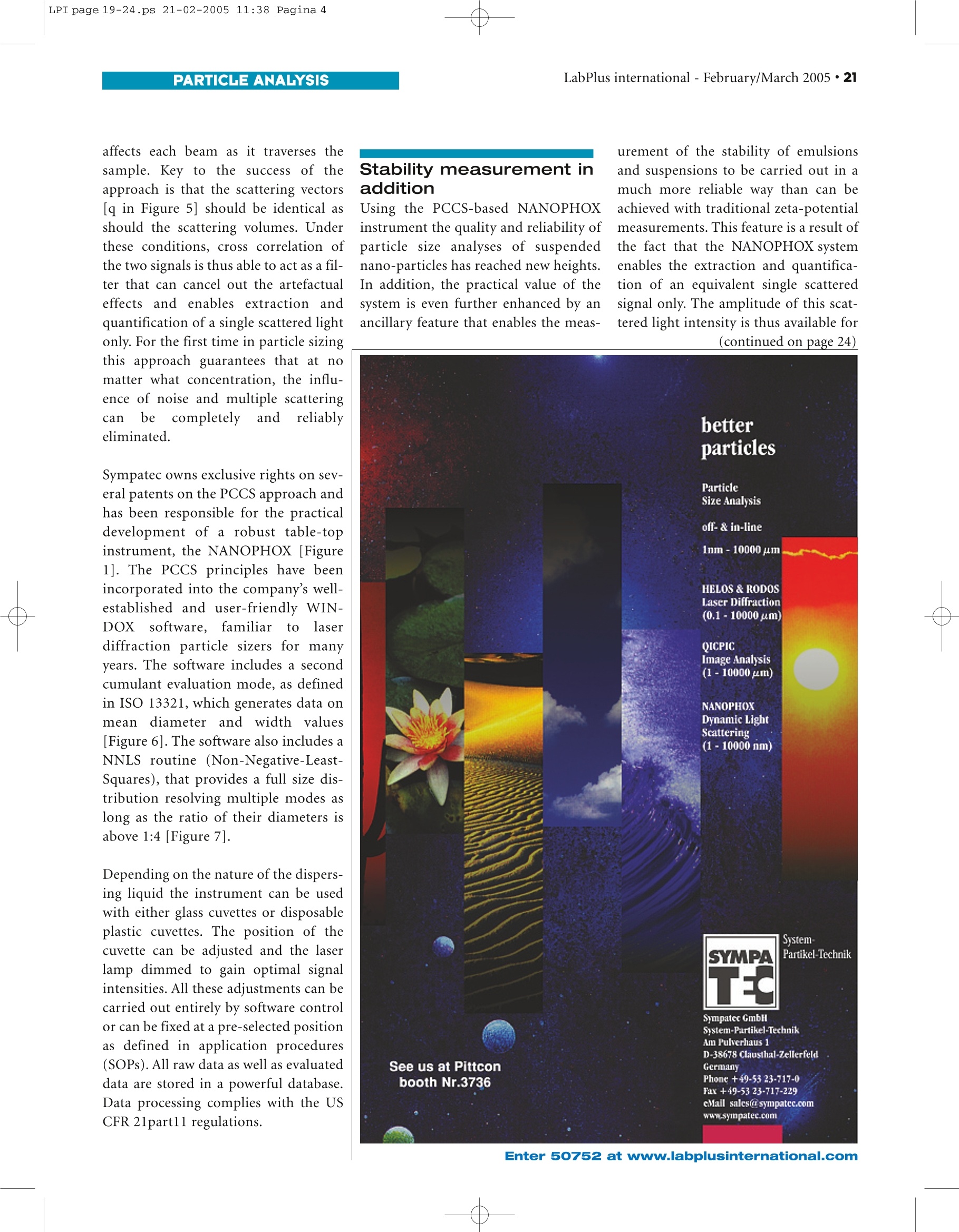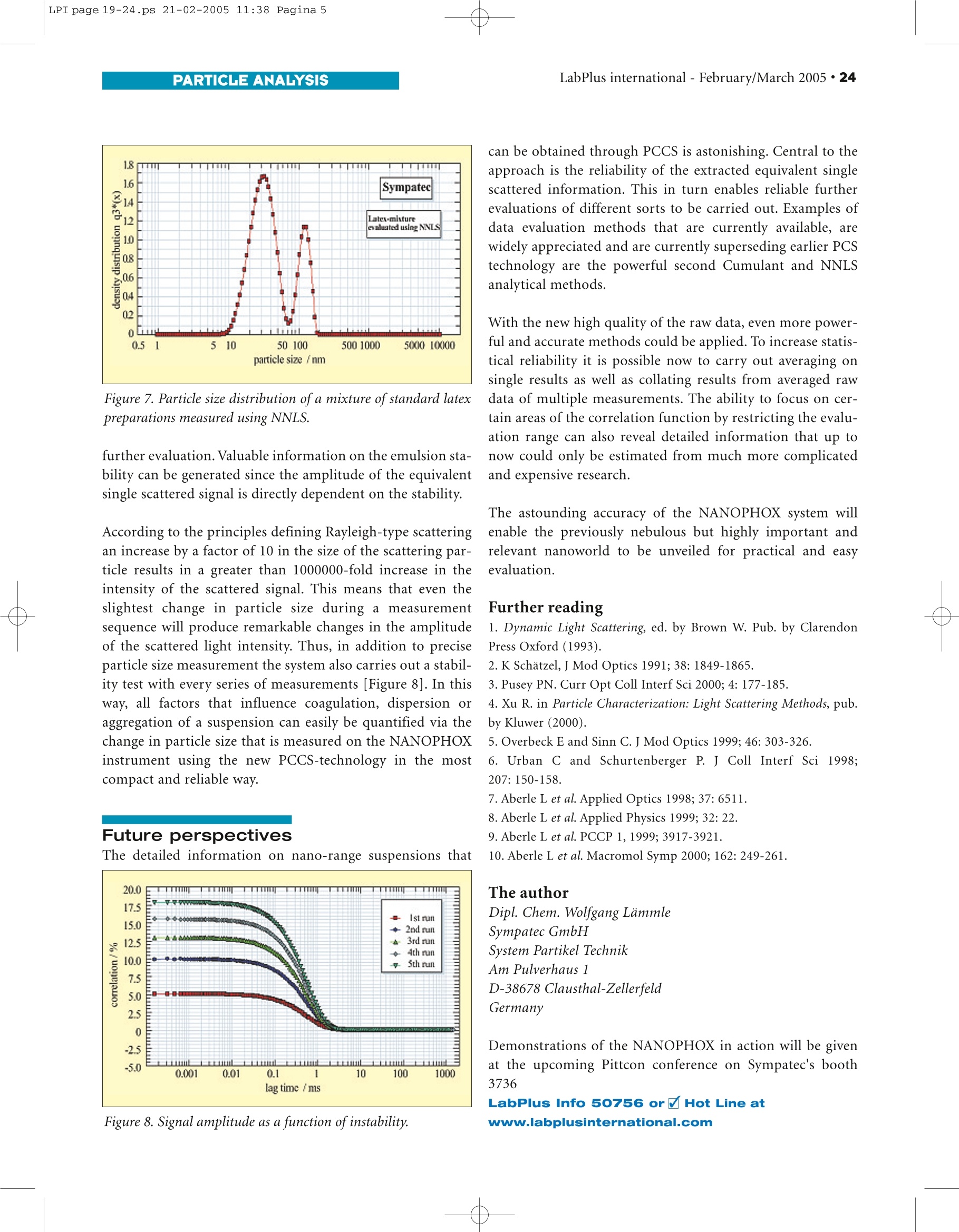
The characteristics of many modern materials are often determined by the properties of nano-particles. This fact is responsible for the fast-growing demand for analysis and control of particle size. The most widely-used technique for this is photon correlation spectroscopy(PCS),which has been in use for almost 30 years now.
方案详情

LPIpage19.ps 22-02-200508:54Pagina 2LabPlus international-February/March 2005·19PARTICLE ANALYSIS Enter 50752 at www.labplusinternational.com Nanometre particle sizing and stabilitymeasurement using a table-top PCCS system by W.Lammle The characteristics of many modern materials are oftendetermined by the properties of nano-particles. This fact isresponsible for the fast-growing demand for analysis andcontrol of particle size. The most widely-used technique forthis is photon correlation spectroscopy (PCS), which hasbeen in use for almost 30 years now. Despite its popularity,PCS however suffers from the disadvantage that it can onlybe applied to highly diluted samples. A recent development,known as photon cross-correlation spectroscopy or PCCS,has dramatically extended the power of the original tech-nique and enables reliable measurements even in high con-centration suspensions. This article describes the theoryandapplications of PCCS and also the practical embodimentof the technique, namely the new NANOPHOX instrumentfrom the Sympatec company. The physical principle Photon correlation spectroscopy (PCS)measures and analyses the fluctuationof the intensity of light scattered from Figure 2. Schematic diagram of the maincomponents of classical PCS. nano-particles in suspension. This fluc-tuationis itself a result of the"Brownian motion" that keeps the par--ticles in steady movement. The mole-cules of a supporting liquid moverandomly at a defined speed that isdetermined by temperature and viscosi-ty. Whenever such molecules collidewith a particle suspended in the liquidan elastic impact is produced, whichmoves the suspended particle. Thespeed at which the particle movesdepends on the size of the particle.Smallparticles will move quicklywhereas coarser particles will move at amuch slower rate since, because of theirgreater volume, such bigger particleshave a statistically-increased chance ofbeing impacted from different direc-tions by more than one molecule at thesame time. This diffusion effect can be describedby the well-known "Stokes-Einstein"equation: Figure 1. Developed and produced bySympatec, the NANOPHOX table-topinstrument is the first to incorporatePCCS technology. where:D is the diffusion constant,kp is Boltzmann’s constant,T is the absolute temperature,n is dynamic viscosity of the liquid,x is the particle diameter. Since the change in the intensity of lightscattered by the particle depends on its Figure 3. Diagram of the main componentsof the new PCCS system. Figure 4. Back scattering. diffusion, it can be seen that the fre-quency of fluctuation of the scatteredlight in turn depends directly on theparticle size. This simple description ofthe light-scattering process presupposesthat the scattered light reaches thedetector without any further interfer- tence by other particles. Such multiplescattering can only be avoided by carry-ing out the analysis at the highest possi-ble dilution where, unfortunately, signalstrength is likely to be very weak andthere will be a low signal-to-noise ratio. Over the years, many approaches havebeen attempted to overcome this multi-ple scattering weakness of PCS. Oneearly approach involved the use ofexperimental set-ups in which the scat-tering was measured at multiple angles.This did allow more sophisticated andpowerful modes of data evaluation(see below) but did not per se avoid the mul-tiple scattering problem. More recently, experimental set-upshave become available that are based onthe measurement of back-scattering.The rationale for the back-scattering isthat multiple scattering may be reducedby allowing the laser beam only to illu-minate a thin surface layer of the sam--ple [Figure 4]. This approach has beenimplemented in several - a an apparent dimension of only some 20nm. Several attempts have been made tocompensate for this intrinsic weaknessof the back-scattering approach byadding further features to the experi-mental set-up. For example, moderninstruments can also measure zeta-potential and carry out determinationof molecular weight. While such add-ons may provide additional ancillaryinformation, they however still do not instruments currentlyon the market. As indicated earlier, thetheory of PCS is basedonthe "Brownianmotion" that is causedby elasticiimpactsbetween molecules inthe supporting liquidand particles suspend- ed in it. In back-scat- Figure 6. Data generated in standard latex preparations by the sec-tering experiments ond cumulant evaluation algorithm. Figure 5. Diagram ofthe theory behind PCCS. In addition, even under such condi--tions, the problem of multiple scatter- Iing is only reduced and cannot be eliminated completely.Furthermore, even if theeffect of multiple scatter-ing can be reduced, theintensity of the scatteredlight signal is also corre-spondingly reduced. The practical effect ofincreasing multiple scat-tering with increasing lightpenetration into the solu- stion results in a particlewith a real size of 104 nmbeing portrayed as having solve the fundamental problem norincrease the basic accuracy and reliabil-ity of the measurement. Photon cross correlationspectroscopy. R&D teams in the German universitiescof Kiel,Mainz, and Bremen and in theETH institute in Zurich, Switzerlandhave developed a new approach knownaas Photon Cross Correlation Spectro-scopy (PCCS) [for references see FurtherReading section]. The experimental lay-out of the PCCS system is illustratedschematically in Figure 3 while Figure 5illustrates the underlying theory. As can be seen from Figures 3 and 5 thePCCS system measures two separatescattered light signals. These signals areiin theory identical to that of a singlescattered light beam but in practice dif-ffer from each other due to differentnoise levels and to the differences in theextent of the multiple-scattering that affects each beam as it traverses thesample. Key to the success of theapproach is that the scattering vectors[q in Figure 5] should be identical asshould the scattering volumes. Underthese conditions, cross correlation ofthetwo signals is thus able to act as a fil-卜ter that can cancel out the artefactualeffects and enables extractionn anCquantification of a single scattered lightonly. For the first time in particle sizingthis approach guarantees that at no.matter what concentration, the influ-ence of noise and multiple scatteringcan be completely and reliablyeliminated. Sympatec owns exclusive rights on sev-eral patents on the PCCS approach andhas been responsible for the practicaldevelopment of a robust table-topinstrument, the NANOPHOX [Figure1]. The PCCS principles have beenincorporated into the company’s well-established and user-friendly WIN-DOXk software,familiar to laserdiffraction particle sizers for manyyears. The software includes a secondcumulant evaluation mode, as definedin ISO 13321, which generates data onmean diameter and width values[Figure 6]. The software also includes aNNLS routine (Non-Negative-Least-Squares), that provides a full size dis-tribution resolving multiple modes aslong as the ratio of their diameters isabove 1:4[Figure 7]. Depending on the nature of the dispers-ing liquid the instrument can be usedwith either glass cuvettes or disposableplastic cuvettes. The position of thecuvette can be adjusted and the laserlamp dimmed to gain optimal signalintensities. All these adjustments can becarried out entirely by software controlor can be fixed at a pre-selected positionas defined in application procedures(SOPs).All raw data as well as evaluateddata are stored in a powerful databaseData processing complies with the USCFR 21part11 regulations. Using the PCCS-based NANOPHOXinstrument the quality and reliability ofparticle size analyses of suspendednano-particles has reached new heights.In addition, the practical value of thesystem is even further enhanced by anancillary feature that enables the meas- (continued on page 24) urement of the stability of emulsionsand suspensions to be carried out in amuch more reliable way than can beachieved with traditional zeta-potentialmeasurements. This feature is a result ofthe fact that the NANOPHOX systemenables the extraction and quantifica-tion of an equivalent single scatteredsignal only. The amplitude of this scat-tered light intensity is thus available for Figure 7.Particle size distribution ofa mixture of standard latexpreparations measured using NNLS. further evaluation. Valuable information on the emulsion sta-bility can be generated since the amplitude of the equivalentsingle scattered signal is directly dependent on the stability. According to the principles defining Rayleigh-type scatteringan increase by a factor of 10 in the size of the scattering par-ticle results in a greater than 1000000-fold increase in theintensity of the scattered signal. This means that even theslightest change in particle size during a measurementsequence will produce remarkable changes in the amplitudeof the scattered light intensity. Thus, in addition to preciseparticle size measurement the system also carries out a stabil-ity test with every series of measurements [Figure 8]. In thisway, all factors that influence coagulation, dispersion oraggregation of a suspension can easily be quantified via thechange in particle size that is measured on the NANOPHOXinstrument using the new PCCS-technology in the mostcompact and reliable way. Future perspectives The detailed information on nano-range suspensions that Figure 8. Signal amplitude as a function ofinstability. can be obtained through PCCS is astonishing. Central to theapproach is the reliability of the extracted equivalent singlescattered information. This in turn enables reliable furtherevaluations of different sorts to be carried out. Examples ofdata evaluation methods that are currently available, arewidely appreciated and are currently superseding earlier PCStechnology are the powerful second Cumulant and NNLSanalytical methods. With the new high quality of the raw data, even more power-ful and accurate methods could be applied. To increase statis-tical reliability it is possible now to carry out averaging onsingle results as well as collating results from averaged rawdata of multiple measurements. The ability to focus on cer-tain areas of the correlation function by restricting the evalu-ation range can also reveal detailed information that up tonow could only be estimated from much more complicatedand expensive research. The astounding accuracy of the NANOPHOX system willenable the previously nebulous but highly important andrelevant nanoworld to be unveiled for practical and easyevaluation. Further reading 1. Dynamic Light Scattering, ed. by Brown W. Pub. by ClarendonPress Oxford (1993). 2. K Schatzel,J Mod Optics 1991;38: 1849-1865. 3. Pusey PN. Curr Opt Coll Interf Sci 2000; 4: 177-185. 4. Xu R. in Particle Characterization: Light Scattering Methods, pub.by Kluwer (2000). 5. Overbeck E and Sinn C. J Mod Optics 1999; 46: 303-326. 6. Urban C and Schurtenberger P. J Coll Interf Sci 1998;207: 150-158. 7.Aberle L et al. Applied Optics 1998; 37: 6511. 8. Aberle L et al. Applied Physics 1999; 32: 22. 9. Aberle L et al. PCCP 1,1999;3917-3921. 10. Aberle L et al. Macromol Symp 2000; 162:249-261. The author Dipl. Chem. Wolfgang LimmleSympatec GmbHSystem Partikel TechnikAm Pulverhaus 1D-38678 Clausthal-ZellerfeldGermany Demonstrations of the NANOPHOX in action will be givenat the upcoming Pittcon conference on Sympatec's booth3736 LabPlus Info 50756 or Hot Line at www.labplusinternational.com
确定




还剩2页未读,是否继续阅读?
德国新帕泰克有限公司苏州代表处为您提供《纳米样品中粒度检测方案(激光粒度仪)》,该方案主要用于纳米材料中粒度检测,参考标准--,《纳米样品中粒度检测方案(激光粒度仪)》用到的仪器有
相关方案
更多








